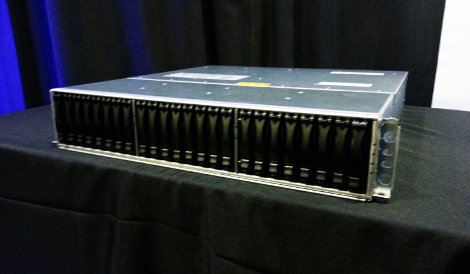NetApp announced its first all-flash storage array and three new products for its enterprise-grade FAS6200 storage-array series Tuesday. While the all-flash array is based on another firm's storage operating system, NetApp previewed its own operating system for all-flash storage it is planning to put on the market early next year.
All-flash storage is a growing market, as the cost of flash is lowering and more and more modern applications demand high storage IOPS and low storage latency. EMC, NetApp's arch nemesis in the enterprise-storage game previewed its all-flash array at Oracle OpenWorld in October 2012, but did not say when it would have an actual product on the market.
The two storage behemoths have a lot of competition in the all-flash market other than each other. They are competing with both young companies, such as Israel's Kaminario and Silicon Valley's Violin Memory, and the IT establishment itself, represented by none other than IBM.
NetApp's EF540 all-flash storage array is built on the SANtricity operating system by LSI Corp. It providers more than 300,000 IOPS with data-access speeds below one millisecond.
Manish Goel, executive VP of product operations at NetApp, addressed the question of competition with all-flash start-ups by saying NetApp had the years of experience in the enterprise market to deliver the reliability enterprises needed – something he implied the young all-flash companies did not necessarily have.
EF540 “combines the performance characteristics of flash with the enterprise-class availability characteristics that we … know and understand really, really well,” Goel said.
The EF540 architecture is fully redundant to give the system enterprise-grade availability. The SANtricity operating system gives it high availability, snapshot and replication, online-management and advanced monitoring features, according to Goel.
The 2U array comes with 12 or 24 drives, with 19.2-terabyte and 9.6-terabyte systems available. It supports FC, SAS, IB and iSCSI access.
Customers using NetApp's flash solutions the vendor highlighted in the announcement included Children's Hospital Central California and Apache Corp.
Kirk Larson, CIO of the Children's Hospital, said NetApp's flash solutions helped the organization improve user experience for high-performance workloads. “Hospital staff members can access the right data at the right time, while IT can deliver a more dynamic and cost-effective infrastructure,” he said.
Bradley Lauritson, director of upstream technology at Apache, said the infrastructure supporting its new software environment for making drilling decisions included flash storage by NetApp, helping avoid data-transfer delays.
The new FAS6200-series arrays are FAS/V6220, FAS6250 and FAS6290. They all support the vendor's flash offerings, which give them a substantial IOPS boost and reduce latency.
NetApp's upcoming operating system for all-flash storage is called FlashRay. The company plans to release the architecture in limited beta around the middle of the year and to make systems generally available early in 2014.
FlashRay is a complete ground-up redesign of the storage operating system, being developed “exclusively for exploiting the capabilities of flash,” Goel said. Designed to support scale-out storage from the get-go, it will include advanced management capabilities like in-line compression and in-line deduplication.
NetApp says it has sold more than 36 petabytes of flash capacity to date. Its flash products have until now been in the category of hybrid systems, using flash to accelerate performance of hard-disk-drive-based systems.

